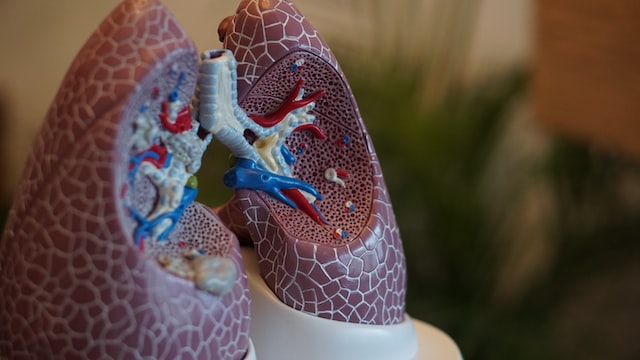Breathing is the process of moving air in and out of the lungs, while respiration is the process of exchanging oxygen and carbon dioxide between the body and the environment.
What is breathing?
(Photo by Egor Vikhrev on Unsplash )

Breathing is the process of inhaling and exhaling air.
When we breathe, air moves in and out of our lungs. This movement of air is caused by pressure differences between the inside and outside of our lungs. The pressure difference is created by the contraction and relaxation of the muscles that surround our lungs. When we inhale, our muscles contract and cause our chest cavity to expand. This increases the volume of our lungs and decreases the pressure inside them. This decrease in pressure causes air to rush into our lungs. When we exhale, our muscles relax and our chest cavity decreases in size. This increase in pressure causes air to be forced out of our lungs.
What is respiration?
The process of respiration occurs when oxygen from the air we breathe diffuses into our blood and is carried to our cells. At the same time, carbon dioxide diffuses from our blood into the alveoli (air sacs) of our lungs and is exhaled.
Respiration is the process of exchanging gases between the air and the blood. This process happens in the lungs and is essential for life. The oxygen that we breathe in is taken up by the blood and delivered to the cells of the body where it is used in cellular respiration to produce energy. The carbon dioxide that is produced by the cells is then carried back to the lungs where it is exhaled.
Breathing and respiration are not the same
There are two types of respiration: Aerobic respiration and Anaerobic respiration. aerobic respiration requires oxygen, while anaerobic respiration does not.
Breathing is a voluntary process that we control, while respiration is an involuntary process that happens automatically. We can choose to hold our breath, but our bodies will continue to exchange oxygen and carbon dioxide regardless.
During exercise, our breathing rate increases to supply more oxygen to our muscles. However, even at rest, our bodies still need to exchange oxygen and carbon dioxide. This is where diffusion comes in. Diffusion is the movement of molecules from an area of high concentration to an area of low concentration.
Breathing Vs. Respiration – Key differences
Breathing and respiration are two fundamental processes related to oxygen intake and carbon dioxide elimination in living organisms, but they have distinct differences. Here are the key points that differentiate them:
Definition:
Breathing: It refers to the physical act of inhaling and exhaling air, involving the movement of the diaphragm and rib muscles to create changes in lung volume and pressure.
Respiration: It encompasses the biochemical reactions that occur within cells to convert oxygen into usable energy, producing adenosine triphosphate (ATP) and releasing carbon dioxide as a byproduct.
Breathing: It is a mechanical process that primarily involves the respiratory system, including the lungs, diaphragm, and associated muscles.
Respiration: It is a complex biochemical process that occurs within cells and involves multiple organelles, particularly mitochondria, where the majority of ATP production takes place.
Purpose:
Breathing: Its main purpose is to facilitate the exchange of gases (oxygen and carbon dioxide) between the external environment and the body. It ensures a constant supply of oxygen for cellular respiration and removes waste carbon dioxide.
Respiration: Its primary goal is to generate energy in the form of ATP through the breakdown of glucose or other fuel molecules in the presence of oxygen. This energy is essential for cellular activities and various physiological processes.
Control:
Breathing: It is under both voluntary and involuntary control. While we can consciously regulate our breathing patterns, the brain’s respiratory centers in the medulla and pons automatically control basic breathing functions.
Respiration: It is an involuntary process that occurs within cells and is regulated by complex biochemical pathways. It is influenced by factors such as cellular energy demands, oxygen availability, and the presence of specific enzymes and coenzymes.
Examples:
Breathing: Taking a deep breath before speaking, holding one’s breath underwater, or feeling shortness of breath during physical exertion are examples of breathing-related experiences.
Respiration: The conversion of glucose into ATP through aerobic respiration in muscle cells during exercise or the production of ATP by brain cells to support cognitive processes are examples of cellular respiration.
Breathing primarily focuses on the mechanical aspect of air exchange, while respiration encompasses the intricate biochemical processes occurring within cells to generate energy. Together, they ensure the oxygen supply and energy needs of the body, showcasing the dynamic interplay between the respiratory system and cellular metabolism.
What are the two types of respiration?
The two types of respiration are aerobic respiration and anaerobic respiration.
Aerobic Respiration:
Aerobic respiration occurs in the presence of oxygen and is the most common and efficient form of respiration. It takes place in the mitochondria of cells and involves a series of chemical reactions that break down glucose and other fuel molecules to produce ATP. Oxygen acts as the final electron acceptor in the electron transport chain, allowing for the complete breakdown of glucose and yielding a high amount of ATP. Aerobic respiration releases carbon dioxide as a byproduct, which is transported back to the lungs for elimination.
Anaerobic Respiration:
Anaerobic respiration occurs in the absence of oxygen or when oxygen supply is limited. It is a less efficient process compared to aerobic respiration. Anaerobic respiration can occur in two ways:
Fermentation: In fermentation, glucose is partially broken down into simpler compounds without the involvement of oxygen. It occurs in the cytoplasm of cells and generates a small amount of ATP. Common examples of fermentation include alcoholic fermentation, as seen in yeast, and lactic acid fermentation, as observed in certain bacteria and muscle cells.
Anaerobic Respiration in Prokaryotes: Some prokaryotes, such as certain bacteria, are capable of performing anaerobic respiration in the absence of oxygen. They use alternative electron acceptors like nitrate or sulfate to carry out the electron transport chain and produce ATP.
While aerobic respiration is the preferred method due to its efficiency, cells can resort to anaerobic respiration when oxygen is limited, ensuring energy production continues to some extent.
Featured Image By – Robina Weermeijer on Unsplash









